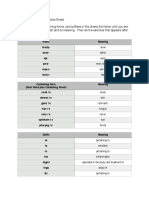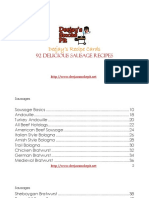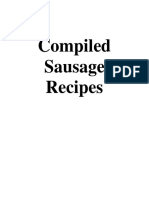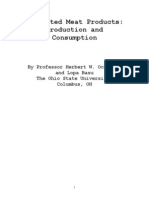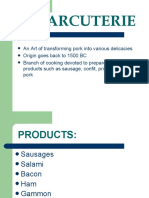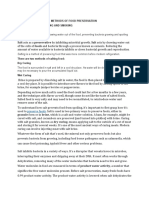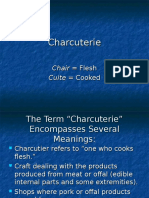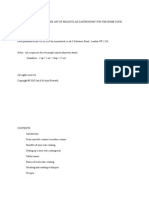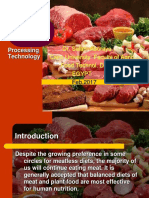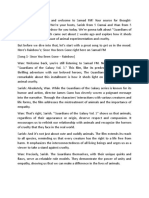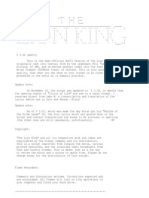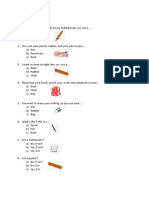Sausages
Sausages
Uploaded by
FarzanaCopyright:
Available Formats
Sausages
Sausages
Uploaded by
FarzanaOriginal Description:
Original Title
Copyright
Available Formats
Share this document
Did you find this document useful?
Is this content inappropriate?
Copyright:
Available Formats
Sausages
Sausages
Uploaded by
FarzanaCopyright:
Available Formats
-- Chef Farzana Avari
HISTORY
DEFINITION
ELEMENTS OF SAUSAGES
FORCEMEATS
CASINGS
CURING AND SMOKING
STEPS OF PREPARATION OF SAUSAGE
SHAPES OF SAUSAGES
POPULAR SAUSAGES ACROSS THE WORLD
Sausages are result of Economical Cookery.
They are one of the oldest prepared food
whether cooked or eaten immediately or
dried to various degrees.
The manufacture of sausages began over two
thousand years ago, and it is still a growing
industry. While some of its basic practices are
almost as old as civilization.
In olden days people did not have refrigeration to
preserve their meat and so making sausage was a
way of overcoming this problem
Basically people living in particular areas developed
their own types of sausage and that sausage became
associated with the area. For example Bologna
originated in the town of Bologna in Northern Italy,
Lyons sausage from Lyons in France and Berliner
sausage from Berlin in Germany, in England they
became associated with the county's, Berkshire,
Wiltshire, Lincolnshire, Cumberland Etc.
In practice for over a millenia sausage-making was
originally a method used to preserve meats,
especially lesser cuts.
A sausage is a generic term for the wide range
of preserved meat products made out of
mincemeat, combined with fat and spices and
stuffed or enclosed in some form of casing.
The word sausage is derived from Old French
saussiche, from the Latin word salsus,
meaning salted.
The term was probably originally applied to
cured or salted meat generally.
The word sausage comes from the Middle
English sausige, which came from sal, Latin
for salt. In France they are sausissons and in
Germany, wurst
MEATS
FATS
SEASONING AND CURE MIXES
BINDING AGENTS
SWEETENERS
Meat
Main Ingredient
Pork preferred meat, due to its neutral flavor and colour
Other Meats Lamb, Beef, Chicken And Game such as,
rabbit, squirrel, wild boar, venison and pheasant.
Use of cheaper cuts of meat or leftovers MYTH
Prime Quality of Meat from tougher cuts of meat Preferred
Offal Defined as the internal parts of an animal
like liver and heart, cooked and eaten as food. As
highly perishable, following safety and hygiene
standards while handling them, is imperative.
Types of Offals
Brain
Pigs Feet
Tongue
Blood
Liver
Caul Fat
Sweetbreads
FATS
One of the most important ingredients.
As a ratio, 25 percent of fat is used in forcemeats,
which would be 50 percent in earlier days.
Less amounts result in dry and crumbly products.
Excess amounts result in shrinkage of final product.
Fat from the jowl of the pig or back of the pig FATBACK
preferred.
Forcemeat of chicken and fish may use double cream as fat.
Fats provide richness, smoothness, flavor and moisture to the
product.
Marbling fat is very important.
Fat from lamb and chicken are avoided as they are strong in
flavor and soft resulting in improper final texture of the product
respectively.
Seasoning and Flavoring
Primarily to impart flavor to bland food.
In olden times, it was done to mask the flavors of
aging meats.
Today, fresh and aromatic seasonings has added a
new dimension to charcuterie.
Some seasonings are native to certain regions and
provinces e.g.: Italian Sausages fresh oregano, thyme and black
pepper
English Sausages -- fresh Tarragon and Parsley
SEASONINGS AND CURE MIXES
Seasonings is limited to a chefs creativity.
From spices to fresh herbs all can be used.
Quatre Epicies cinnamon, cloves, peppercorns and nutmeg
Apart from salt, dried onions, garlic, celery can be used.
Sauted onions and shallots and deglaze with white wine ,
mixed with diced meats and marinated overnight gives
excellent seasoning to the final product.
Sausages that are dried or cold smoked
should be cured imperatively.
CURING Treating the sausage meat with
chemical salts. Commonly used curing agents
are :
Sodium Chloride Preservation and flavor only
Sodium Nitrite Preserves Meat from growth of
Clostridium Botulinum and enhances meat colour.
Phosphates Stabilizes the texture, retains juices and water
in the meat and aids in water binding capacity, thus sausages
after cooking do not get dried and retain natural juices.
Ascorbic Acid Preserves the flavor of the meat and prevents
against fungi and yeast. It is a good anti oxidant and helps
retain colour.
Prague Powder I 94% Sodium Chloride +6% Sodium Nitrite,
used in wet cures and products smoked and canned.
Prague Powder II -- 94% Sodium Chloride +5.8% Sodium
Nitrite +0.2% Sodium Nitrate, used in dry cures , most
suitable for salamis and not suitable for products to be fried
like bacon.
Tinted Curing Mix(TCM) 94%sodium chloride+6%sodium
nitrite _ pink color, 113 g suffices for 45 kg of meat
Binding Agents
Myosin
Soy Protiens
Milk Powder & Corn Syrup 12% and 5% resp. of total
mix
Eggs and Cream Mix, Panada(10% of total mix) Choux
pastry, Cooked Rice and Soaked Bread slices
Sweeteners
They serve as food to necessary bacteria which
helps develop mellow flavors and also promote
browning.
Dextrose Preferred to grain sugar as it
penetrates quickly and more effectively
Honey, Corn Syrup etc
It is the base for all charcuterie products.
It is described as an emulsion of meats and fats that
is created by mixing meat and fat either by
chopping, grinding or pureeing them together.
Types of Forcemeats:
Basic Forcemeat Straight Mix
Country Style Use of offal meats, hand chopped, use of
panada
Gratin Not used for sausages, but for inlay of pates and
terrines
Mousseline - Lightest, smoothest of all with soft white
meats.
Natural Casings
Obtained naturally from the animals are usually,
the small or large intestine of the animal used as
casing.
Size of the casing varies from 16 mm to 127 mm in
diameter.
Beef Middles or Sewed Hog Bungs
Dry Salted Can be stored for a few years
Wet Packed Perishable
Man-Made or Synthetic
Artificially made they are preferred to natural casing.
They offer better quality control and standard size
and shape.
Plastic Casing Suitable for cooked Sausages.
Collagen Casing Made of animal collagen.
Fibrous Casing/Cellulose Casing Suitable for air dried
and not cooked Sausages made of non edible plant
protein
Polymer Casing Made of high strength polymer, heat
resistant and can be cooked and stored
Most important process of Sausage Making
Helps Prevent Bacterial Contamination
Clostridium Botulinum
First Curing Agent - Potassium nitrate Saltpeter
Due to inconsistent results banned since 1975
Nitrates take a longer time ton break down and
hence give better consistent results.
High amounts of nitrates and nitrites can cause
chemical food poisoning.
Dry Cure
Combination of salt, sweetener, curing agents herbs and
seasonings.
300g of dry cure is used for every 5 kg of meat.
1/4th inch of meat can be cured in 2-3 hours.
The process can be as lengthy as 45-50 days as for ham on
the bone
Temperature and humidity play an important role,
especially when curing for more than two days.
Once cured, the meat is rinsed and left to dry in cold
storage for at least 12 hours
This helps in forming the pellicle
Wet Cures
Contains same ingredients as dry cures with
water added.
This salty solution is also known as brine. Used
for products which are going to be cooked and final
product may have more moisture
It is a quicker process through brine injectors.
Once cured the product is rinsed and left to dry
and form a pellicle.
Smoking not only imparts flavor and colour, but
the chemicals present in the smoke also inhibit
bacterial growth thereby preserving food .
Most commonly woods used for smoking are
oak, cider, hickory, cherry etc..
Smoking is always done after curing and hence
intensifies the flavors and preserves the food.
Cold Smoking
Temperature maintained in smoking chamber is
less than 30OC
It does not cook the product.
It is applied to products that need not be cooked
It results in dehydration of the product.
Its applied to products which have undergone dry
curing.
Hot Smoking
It helps cooking the product during the process.
The heat is the chamber coagulates the protiens
on the surface of the meat
While applying smoke, internal temperature of the
meat should be 650Cto 750C.
It is important for the formation of pellicle on the
product as it helps smoke to stick to the surface of
the product.
Step 1:- Select the Ingredients
Step 2 :- Grind the meat
Step 3:- Prepare casing
Step 4:-Stuff The Casing
Step 5:- Cook, Cure and smoke the sausages
Rope Sausages
Linking Sausages
Chaining Sausages
Looping Sausages
Kielbasa /Polish Sausage Poland
Bratwurst German
Frankfurters German
Salami Italy, France, Germany & European
Countries
Mortadella Italian
Breakfast Sausages USA
Cumberland Sausages
Cumbria (North West Of England)
Chorizos Spain And Portugal
Loukanika Greece
Merguez North Africa
Boudin Noir France
Boudin Blanc France
Bonne Appetite
You might also like
- Medical Terminology Practice SheetsDocument7 pagesMedical Terminology Practice Sheetsmarcus colgrove100% (3)
- The Art of Making Fermented SausagesDocument312 pagesThe Art of Making Fermented SausagesIonescuTeodora100% (2)
- Sausage Book PDFDocument208 pagesSausage Book PDFBuzzard95111175% (8)
- Persuasive Speech OutlineDocument2 pagesPersuasive Speech Outlineali alhayekNo ratings yet
- SausagesDocument205 pagesSausagescarlos sandoval100% (1)
- Fresh Sausage KitDocument12 pagesFresh Sausage KitMarco Aurélio100% (1)
- Sausage - Safe ProductionDocument96 pagesSausage - Safe Productionfullquiverfarm100% (4)
- Salami Flow ChartDocument1 pageSalami Flow Charttiffanyleecraig50% (2)
- The Complete Art and Science of Sausage PDFDocument3 pagesThe Complete Art and Science of Sausage PDFHoài NamNo ratings yet
- CompiledSausageRecipes PDFDocument106 pagesCompiledSausageRecipes PDFJelena Simic100% (3)
- Mortadella Bologna IGPDocument21 pagesMortadella Bologna IGPmajstorNo ratings yet
- OrgasmDocument178 pagesOrgasmManish Kushwaha100% (2)
- Perspectives: Beyond The G Spot: Clitourethrovaginal Complex Anatomy in Female OrgasmDocument8 pagesPerspectives: Beyond The G Spot: Clitourethrovaginal Complex Anatomy in Female OrgasmVissente TapiaNo ratings yet
- Sausage Production Processing InsightDocument5 pagesSausage Production Processing InsightAmy Zhai0% (1)
- SausagesDocument56 pagesSausagesrupinisinnanNo ratings yet
- Unit 2 CharcuterieDocument23 pagesUnit 2 Charcuteriesai kiranNo ratings yet
- Meat Curing Made Easy - Sausage Making and Many Uses for Morton's SaltFrom EverandMeat Curing Made Easy - Sausage Making and Many Uses for Morton's SaltNo ratings yet
- Meat Preservation: SausageDocument49 pagesMeat Preservation: SausageJiana Nasir100% (1)
- FermentedDocument108 pagesFermentedCHOFOR VITALIS100% (2)
- Charcuteria Libro PDFDocument313 pagesCharcuteria Libro PDFFederico Gómez100% (1)
- CHARCUTERIEDocument4 pagesCHARCUTERIEHariz JokerNo ratings yet
- Basics of Sausage MakingDocument48 pagesBasics of Sausage MakingDanny Mokdad100% (2)
- Meat BasicsDocument97 pagesMeat BasicsPrincess Joy Morales100% (1)
- Home Sausage Makingnd EdDocument17 pagesHome Sausage Makingnd EdMarcelo macedoNo ratings yet
- CHARCUTERIEDocument29 pagesCHARCUTERIEyashyash_007100% (4)
- Meat CutsDocument2 pagesMeat CutsTodd Parsnick100% (1)
- CheeseDocument60 pagesCheeseshivkumar100% (3)
- Home Production of Quality Meats and Sausages (PDFDrive)Document863 pagesHome Production of Quality Meats and Sausages (PDFDrive)Francisco Marcano67% (3)
- Meat ProcessingDocument26 pagesMeat ProcessingWriting ScholarsNo ratings yet
- 18 - PH Measurement in The Acidification Process of Fermented SausagesDocument2 pages18 - PH Measurement in The Acidification Process of Fermented SausagesDavid Suarez Chacon100% (2)
- FinalDocument38 pagesFinalNithyanandan Mohan100% (2)
- How To Make A Chicken Biryani - 8 Steps (With Pictures) - WikiHowDocument10 pagesHow To Make A Chicken Biryani - 8 Steps (With Pictures) - WikiHowriaz11121No ratings yet
- Making Prosciutto From ScratchDocument12 pagesMaking Prosciutto From ScratchSusan Coleman100% (1)
- The Sausage BookDocument97 pagesThe Sausage BookMurat TokçaerNo ratings yet
- The Art and Practice of Sausage MakingDocument12 pagesThe Art and Practice of Sausage Makinglokikg100% (5)
- Sausage Bacon and JerkyDocument56 pagesSausage Bacon and JerkyBekezela Mbondiah Ruwona100% (3)
- EMULSIFIED MEAT PRODUCTS ReviewDocument7 pagesEMULSIFIED MEAT PRODUCTS ReviewCHOFOR VITALISNo ratings yet
- Sausage MakingDocument135 pagesSausage Makingmarcela33j9603No ratings yet
- Flavored SausagesDocument9 pagesFlavored SausagesRJN4444No ratings yet
- Dry Aged MeatDocument2 pagesDry Aged MeatTrajan AureliusNo ratings yet
- The Food Lab's Complete Guide To Pan-Seared SteaksDocument13 pagesThe Food Lab's Complete Guide To Pan-Seared SteaksMichael RyanNo ratings yet
- Pork ButcheringDocument211 pagesPork ButcheringLuis Sebastiao100% (3)
- How To Cure Bacon at Home - Small Footprint Family™Document3 pagesHow To Cure Bacon at Home - Small Footprint Family™MaDope August Ridho RiwuNo ratings yet
- Cold CutsDocument25 pagesCold CutsalphinxkNo ratings yet
- Salt Acts As A Preservative by Inhibiting Microbial Growth. Salt Acts by Drawing Water OutDocument14 pagesSalt Acts As A Preservative by Inhibiting Microbial Growth. Salt Acts by Drawing Water OutMaLyn Maravilla100% (1)
- CharcuterieDocument41 pagesCharcuteriecarlo jay evardoneNo ratings yet
- Food Additives PDFDocument12 pagesFood Additives PDFHerianka DefriNo ratings yet
- CharcuterieMaster 01Document62 pagesCharcuterieMaster 01Marijan Martinović80% (5)
- Djs Brining BookDocument34 pagesDjs Brining Booklaliaga30No ratings yet
- Sous Vide and Molecular CuisineDocument38 pagesSous Vide and Molecular Cuisineianjhowarth50% (2)
- Sausage BookDocument271 pagesSausage BookVanderson Soares100% (2)
- Chef Basics Marinades & RubsDocument21 pagesChef Basics Marinades & Rubsbillymac303a100% (1)
- Smoked Sausage Penn DutchDocument1 pageSmoked Sausage Penn DutchNikoNo ratings yet
- The Sausage Maker Blog - DIY Dry Curing - How To Make SalamiDocument8 pagesThe Sausage Maker Blog - DIY Dry Curing - How To Make SalamiAugust Ridlof Riwu100% (1)
- Meat Processingفبراير2017Document195 pagesMeat Processingفبراير2017Mercedes Galeon100% (1)
- Meat Processors Journal v3 PDFDocument160 pagesMeat Processors Journal v3 PDFHoài Nam100% (1)
- Fermentation of Meat and FishDocument25 pagesFermentation of Meat and FishArishaFatima100% (2)
- Sausage BookDocument208 pagesSausage BookBuzzard951111100% (1)
- Dry-Aging of Beef: Executive SummaryDocument16 pagesDry-Aging of Beef: Executive SummaryRemya Pillai100% (1)
- The Complete Guide to Sausage Making: Mastering the Art of Homemade Bratwurst, Bologna, Pepperoni, Salami, and MoreFrom EverandThe Complete Guide to Sausage Making: Mastering the Art of Homemade Bratwurst, Bologna, Pepperoni, Salami, and MoreNo ratings yet
- The Sausage-Making Cookbook: Complete instructions and recipes for making 230 kinds of sausage easily in your own kitchenFrom EverandThe Sausage-Making Cookbook: Complete instructions and recipes for making 230 kinds of sausage easily in your own kitchenRating: 5 out of 5 stars5/5 (3)
- Double Fertilization in PlantsDocument24 pagesDouble Fertilization in PlantsAshmit Srinjoy DuttaNo ratings yet
- Animal Testing GapDocument3 pagesAnimal Testing GaprioNo ratings yet
- Els 308 Language and CommunicationDocument12 pagesEls 308 Language and CommunicationTaiwo DamilolaNo ratings yet
- Laboratory Exercise 1Document8 pagesLaboratory Exercise 1Xyrene DelloroNo ratings yet
- Sumara Gaspar - Short Stories - Hawaiian MythologyDocument7 pagesSumara Gaspar - Short Stories - Hawaiian Mythologyapi-572157085No ratings yet
- Mitigation Measures For Road Projects Cutting Through Tiger Corridors in The Eastern Vidarbha LandscapeDocument6 pagesMitigation Measures For Road Projects Cutting Through Tiger Corridors in The Eastern Vidarbha LandscapeHemant GaikwadNo ratings yet
- Test Question & AnswerDocument5 pagesTest Question & Answerrosalyn sugay100% (2)
- Open QuestionsDocument32 pagesOpen QuestionsMostafa FayadNo ratings yet
- Samad FM Animal Cruelty ScriptDocument2 pagesSamad FM Animal Cruelty ScriptMercuryJupiter 101No ratings yet
- Lion King TheDocument64 pagesLion King TheJeimer JimenezNo ratings yet
- English TestDocument5 pagesEnglish TestArs SyfaNo ratings yet
- Parative AdjectivesDocument1 pageParative AdjectivesADRIAN CABRERA CASTILLO100% (2)
- Felidae - WikipediaDocument37 pagesFelidae - Wikipediasatrio eko wicaksonoNo ratings yet
- Lesson Plan in English 2 Q3 LiteracyDocument10 pagesLesson Plan in English 2 Q3 LiteracyEllyson JeremillosNo ratings yet
- Basic Measures For First AidDocument21 pagesBasic Measures For First AidRhy Enne CelestialNo ratings yet
- 2018 Ises Training Principles PosterDocument1 page2018 Ises Training Principles Posterapi-306398192No ratings yet
- The-PromiseDocument144 pagesThe-PromiseRachael0% (1)
- Comparative and Superlative ExercisesDocument5 pagesComparative and Superlative ExercisesJhordan Vasquez SNo ratings yet
- 10 - Chapter 2 PDFDocument41 pages10 - Chapter 2 PDFashish.walleNo ratings yet
- Week 6 Sept.23-26, 2019Document13 pagesWeek 6 Sept.23-26, 2019Heidi Dalyagan DulnagonNo ratings yet
- GASTROINSTINAL TRACT Robbins 8th EditionDocument4 pagesGASTROINSTINAL TRACT Robbins 8th EditionLim EricNo ratings yet
- Fungal InfectionsDocument9 pagesFungal InfectionsCoral Srinivasa RamaluNo ratings yet
- Glencoe Reading ComprehensionDocument96 pagesGlencoe Reading ComprehensionQamar Zahoor100% (1)
- Presentation 1Document54 pagesPresentation 1Ishtiaq Hasan100% (1)
- Medical Terminology Review - Crossword LabsDocument2 pagesMedical Terminology Review - Crossword LabsShashi Royal TNNo ratings yet
- A2 Speaking Part 1Document5 pagesA2 Speaking Part 1Nguyễn Hoàng Xuân Chiêu100% (1)
